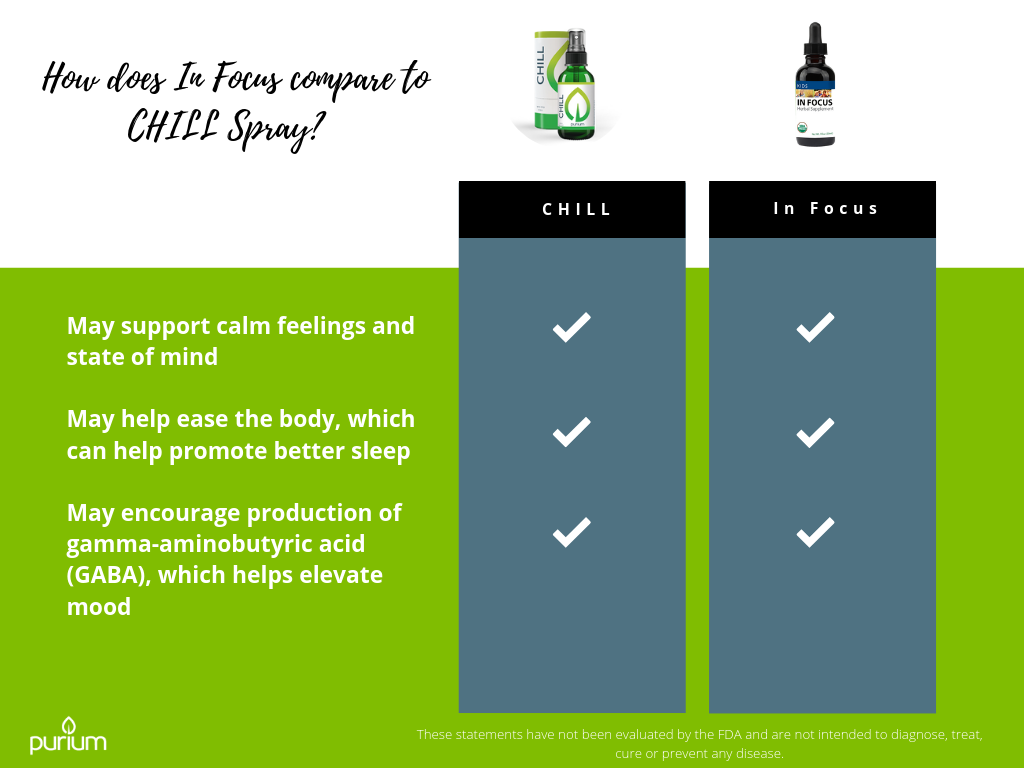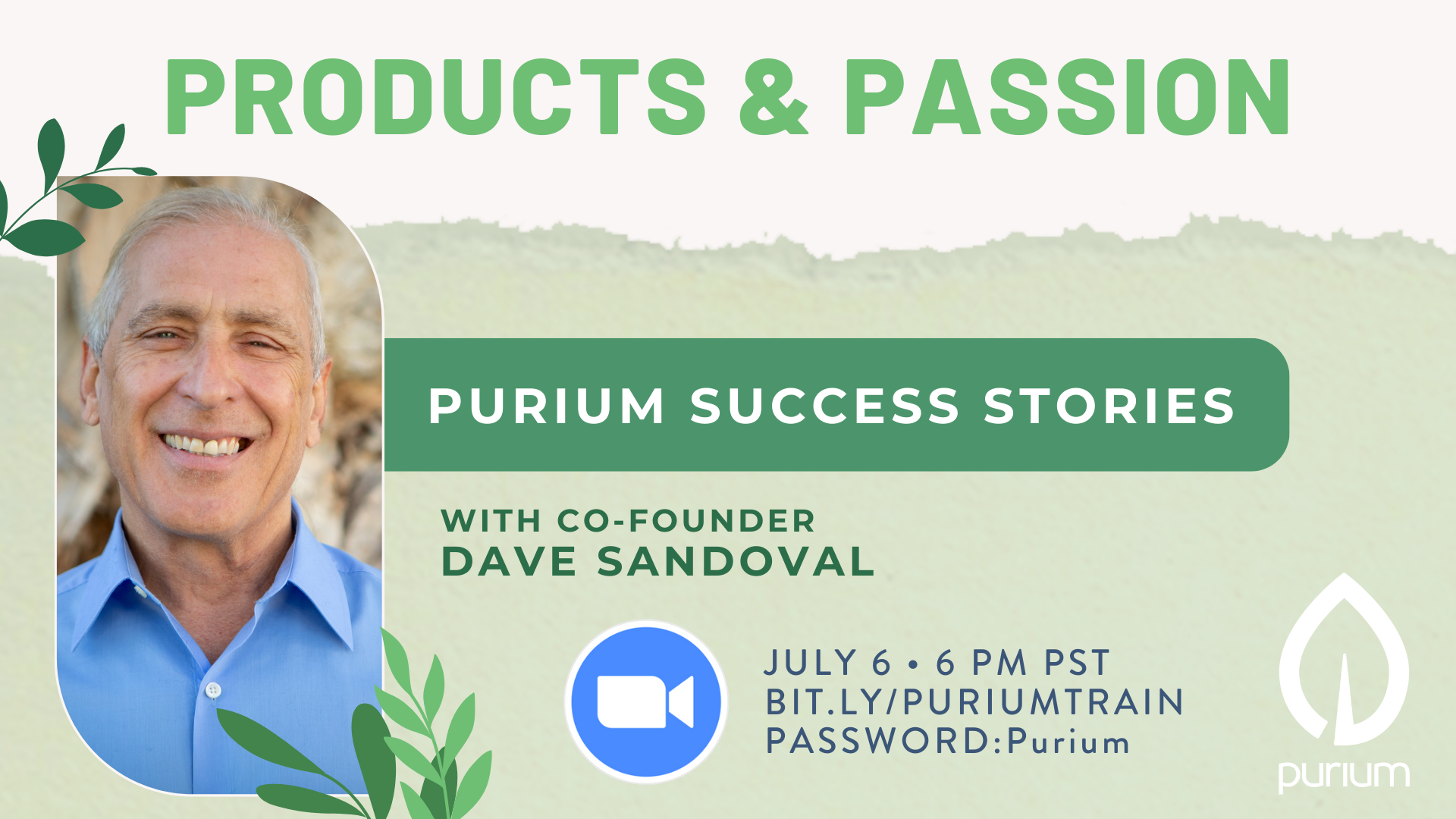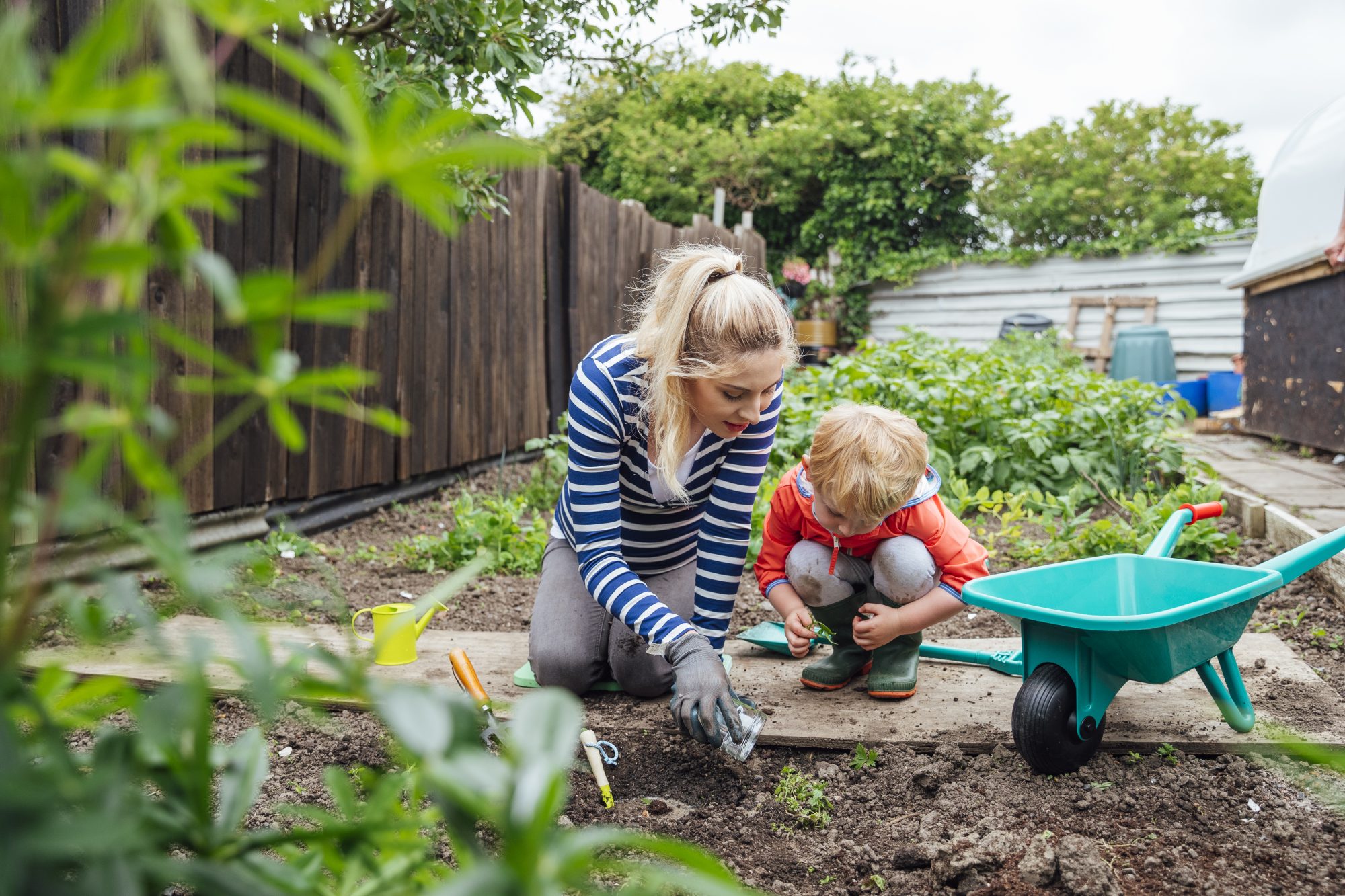Updated September 2020
In 2019, we made a tough decision to discontinue our CHILL spray. Why did we do this? Our manufacturing partner switched up the formula, so it no longer followed our pure and premium standards. Unable to reach a negotiation, we’ve stopped stocking the spray until further notice. We understand that the product helped many of you find comfort from uncomfortable symptoms, as well as help provide peace of mind.
What made CHILL so special was its ability to soothe the body and mind. Our Co-Owners Dave Sandoval and Amy Venner-Hamdi recommend two other products that can help do just the same: CBD+ and Kids In Focus.
CBD+ is gaining more and more recognition as the health world learns more about the benefits of the cannabis plant; however, In Focus has been flying under the radar since its release. So, we’re shedding some light.
Today, we’re going to spotlight In Focus, showing you how it can possibly perform just as well as CHILL. In fact, you’ll find that its ingredients support similar mood-boosting benefits.
Product Spotlight: In Focus
What is Kids In Focus?
Based in organic vegetable glycerin and deionized water, this powerful combination of herbs helps support a calm mood, while promoting mindful focus and balanced energy. While intended for children, this blend can be used by adults too!
How Do You Use It?
Although it’s in liquid form like CHILL, this product is not a sublingual spray. Instead, use the dropper to add it to your water, shakes, smoothies or juices. Generally, we recommend using it two to three times per day. Dosages vary according to weight and personal preference.
What Are the Plant-Based Ingredients?
Like 100% of Purium products, we only use natural ingredients, like fruits, fresh veggies, plants, herbs and minerals. Here’s what makes up In Focus.
Organic Eleuthero Root
Summary: Eleuthero helps support the body’s response to stress, as well as benefits brain health and energy.
Also known as Siberian ginseng, Chinese and Korean holistic medicine practitioners love this herb for its abilities. As an adaptogen, this root naturally support the body’s response to stress. (1) While studies may be a bit sparse, the University of Michigan’s medicine guide recognizes the root’s ability to help support adrenal function when the body is dealing with the effects of stress.
What’s more, this root has been shown to promote positive brain health benefits. One study published in Molecules reports that this ginseng can help activate specific brain chemicals that help the body respond to change and boost energy. (2)
Another super cool brain benefit of this herb? Studies show that it may help boost learning and memory collection (3). One of the possible reasons for this is due to the plant’s ability to help decrease oxidation stress, which may help improve memory formation. (4)
Organic Lemon Balm Herb
Summary: Lemon balm may support the body’s response to stress, relieve sleep issues and encourage gamma-aminobutyric acid (GABA) production.
What is lemon balm? First of all, it’s not a lemon (although its leaves smell just like them). In fact, it’s an herb in the mint family. It’s most often used to help ease symptoms of insomnia and headaches. A study published in Phytomedicine found that child participants who took a dose of this herb enjoyed up to an 80% improvement in restless symptoms. (5) It’s worth mentioning the children consumed a combination of both lemon balm and valerian (another herb).
Here’s another interesting benefit. Lemon balm has been shown to help reduce stress and anxiety. One specific study published in Nutrients documented participants mood improvement when they consumed foods containing lemon balm (6).
One of the reason’s this herb may help balance mood is due to its ability to help encourage the body’s natural GABA production (7). GABA is a neurotransmitter that can help boost mood and relax the body.
Organic Chamomile Flower
Summary: This flower contains antioxidants and helps the body fight symptoms of anxiety and depression. It can also support better sleep.
Chances are you’ve heard of chamomile before, so we won’t go to deep into this one. You can find a tea tincture or blend in virtually any market. And that’s for a good reason: it’s an herb that stands the test of time. Since forever, chamomile has been used to help ease the mind, the stomach and the body.
Molecular Medicine Reports suggests this plant’s antioxidant-content makes it so beneficial. (8) One specific antioxidant, apigenin, can even help you sleep.
What’s more, an exploratory study published in Alternative Therapies in Health and Medicine and Pharmacognosy Review found chamomile tea was able to provide anti-depressant-like effects when compared to a placebo. (9)
Organic Passionflower
Summary: Passionflower may help relieve symptoms of anxiety and encourage better sleep. This herb may also support the body’s GABA production, helping to boost mood.
Like chamomile, passionflower is one of the more popular herbs and most studied. Luckily, there are several studies that explore its benefits. It’s anxiety-relieving ability is most often tied to its sedative-like effect, which may be related to its GABA-producing properties. (10)
And it’s just as promising for sleep. One double-blind study found that passionflower tea helped healthy adults sleep better when compared to a placebo. (11)
Final Thoughts – How Does In Focus Compare to CHILL?
We learned a lot today. So, let’s review. Here’s what In Focus has in common with CHILL spray:
- Supports calm feelings and state of mind
- Helps ease the body and supports better sleep
- Encourages GABA-production in the brain, supporting mood elevation and memory-formation
We hope you love In Focus just as much as we do! Have a testimonial? Let us know in the comments or in our submission box.
Cited Studies
- Wagner, H., Nörr, H., & Winterhoff, H. (1994). Plant adaptogens. Phytomedicine, 1(1), 63-76.
- Miyazaki, S., Oikawa, H., Takekoshi, H., Hoshizaki, M., Ogata, M., & Fujikawa, T. (2019). Anxiolytic Effects of Acanthopanax senticosus HARMS Occur via Regulation of Autonomic Function and Activate Hippocampal BDNF–TrkB Signaling. Molecules, 24(1), 132.
- Cicero, A. F. G., Derosa, G., Brillante, R., Bernardi, R., Nascetti, S., & Gaddi, A. (2004). Effects of Siberian ginseng (Eleutherococcus senticosus maxim.) on elderly quality of life: a randomized clinical trial. Archives of Gerontology and Geriatrics, 38, 69-73.
- Pesce, M., Tatangelo, R., La Fratta, I., Rizzuto, A., Campagna, G., Turli, C., … & Ballerini, P. (2018). Aging-related oxidative stress: positive effect of memory training. Neuroscience, 370, 246-255.
- Müller, S. F., & Klement, S. (2006). A combination of valerian and lemon balm is effective in the treatment of restlessness and dyssomnia in children. Phytomedicine, 13(6), 383-387.
- Scholey, A., Gibbs, A., Neale, C., Perry, N., Ossoukhova, A., Bilog, V., … & Buchwald-Werner, S. (2014). Anti-stress effects of lemon balm-containing foods. Nutrients, 6(11), 4805-4821.
- Awad, R., Muhammad, A., Durst, T., Trudeau, V. L., & Arnason, J. T. (2009). Bioassay‐guided fractionation of lemon balm (Melissa officinalis L.) using an in vitro measure of GABA transaminase activity. Phytotherapy Research: An International Journal Devoted to Pharmacological and Toxicological Evaluation of Natural Product Derivatives, 23(8), 1075-1081.
- Srivastava, J. K., Shankar, E., & Gupta, S. (2010). Chamomile: A herbal medicine of the past with a bright future. Molecular medicine reports, 3(6), 895-901.
- Amsterdam, J. D., Shults, J., Soeller, I., Mao, J. J., Rockwell, K., & Newberg, A. B. (2012). Chamomile (Matricaria recutita) may have antidepressant activity in anxious depressed humans-an exploratory study. Alternative therapies in health and medicine, 18(5), 44.
- Kim, M., Lim, H. S., Lee, H. H., & Kim, T. H. (2017). Role identification of Passiflora incarnata linnaeus: A mini review. Journal of menopausal medicine, 23(3), 156-159.
- Ngan, A., & Conduit, R. (2011). A double‐blind, placebo‐controlled investigation of the effects of Passiflora incarnata (Passionflower) herbal tea on subjective sleep quality. Phytotherapy research, 25(8), 1153-1159.





